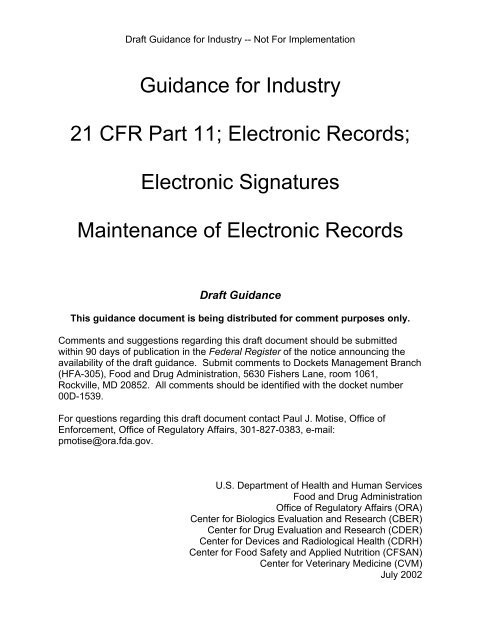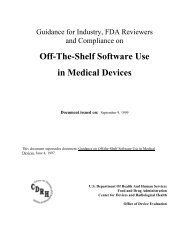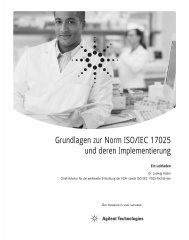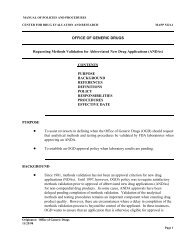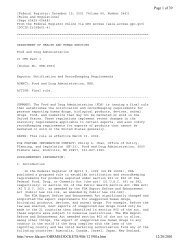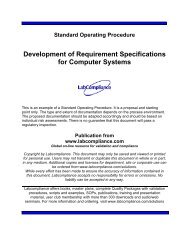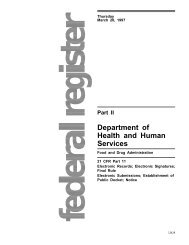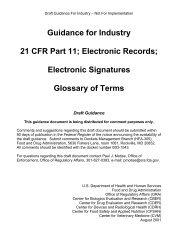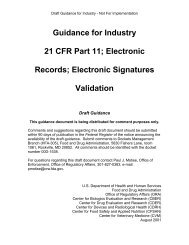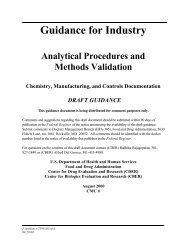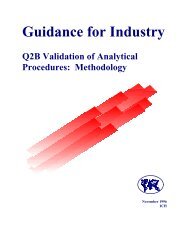Guidance for Industry 21 CFR Part 11; Electronic Records
Guidance for Industry 21 CFR Part 11; Electronic Records
Guidance for Industry 21 CFR Part 11; Electronic Records
Create successful ePaper yourself
Turn your PDF publications into a flip-book with our unique Google optimized e-Paper software.
Draft <strong>Guidance</strong> For <strong>Industry</strong> – Not For Implementation2. ScopeThis draft guidance is one of a series of guidances about part <strong>11</strong>. We intend to providein<strong>for</strong>mation with respect to FDA's current thinking on acceptable ways of meeting part<strong>11</strong> requirements to ensure that electronic records and electronic signatures aretrustworthy, reliable, and compatible with FDA's public health responsibilities. This draftguidance focuses on maintenance of electronic records.When an FDA regulation requires that a record be maintained, generally the regulationspecifies the period of time the record must be kept (referred to in this draft guidance asthe records retention period). We intend this draft guidance to apply to the entirerequired retention period regardless of how actively the records are used or accessed.This draft guidance presents key principles and practices and addresses somefrequently asked questions, but it is not intended to cover everything about maintainingelectronic records. The guidance provides two examples of approaches to electronicrecord maintenance.This document includes some considerations that are also relevant to recordingin<strong>for</strong>mation in the first place. If in<strong>for</strong>mation is inaccurately or incompletely recorded,record maintenance practices will not compensate <strong>for</strong> those shortcomings.2
Draft <strong>Guidance</strong> For <strong>Industry</strong> – Not For Implementation• Section <strong>11</strong>.10(a): “Validation of systems to ensure accuracy, reliability,consistent intended per<strong>for</strong>mance, and the ability to discern invalid or alteredrecords.”• Section <strong>11</strong>.10(b): “The ability to generate accurate and complete copies ofrecords in both human readable and electronic <strong>for</strong>m suitable <strong>for</strong> inspection,review, and copying by the agency.”• Section <strong>11</strong>.10(d): “Limiting system access to authorized individuals.”• Section <strong>11</strong>.10(e): Use of secure, computer-generated, time-stamped, audittrails that, among other things, "shall be retained <strong>for</strong> a period at least as longas that required <strong>for</strong> the subject electronic records and shall be available <strong>for</strong>agency review and copying."• Section <strong>11</strong>.50: Signed electronic records shall contain in<strong>for</strong>mation associatedwith the signing that clearly indicates the printed name of the signer, the dateand time of signing and what the signature means. These items shall be"subject to the same controls as <strong>for</strong> electronic records and shall be includedas part of any human readable <strong>for</strong>m of the electronic record (such aselectronic display or printout)." Accordingly, the signature manifestationin<strong>for</strong>mation, associated with an electronic record that is subject to this5
Draft <strong>Guidance</strong> For <strong>Industry</strong> – Not For Implementationrequirement, must be maintained <strong>for</strong> the duration of the record retentionperiod.• Section <strong>11</strong>.70: "<strong>Electronic</strong> signatures and handwritten signatures executed toelectronic records shall be linked to their respective electronic records toensure that the signatures cannot be excised, copied, or otherwisetransferred to falsify an electronic record by ordinary means."Implementation of these and other part <strong>11</strong> controls will help to ensure that yourmaintained electronic records will be trustworthy, reliable, authentic, and compatiblewith FDA's public health responsibilities.4.2 What Do Predicate Rules Require?In addition to establishing records retention periods, predicate rules, among otherthings, establish record content and signing requirements. It is beyond the scope of thisdocument to enumerate these requirements. However, keep in mind that electronicrecords must still meet predicate rule content and signing requirements, and they mustbe retained <strong>for</strong> as long as the predicate rule requires.6
Draft <strong>Guidance</strong> For <strong>Industry</strong> – Not For Implementation5. General Considerations For <strong>Electronic</strong> <strong>Records</strong> MaintenanceWe believe it is very important that the factors unique to the maintenance of electronicrecords are controlled and work properly together so that people can accurately andreadily retrieve and use the in<strong>for</strong>mation that was originally intended to be preserved andpresented. We believe the following principles and practices will help meet thatobjective.5.1 Procedures For <strong>Electronic</strong> <strong>Records</strong> Maintenance Should Be Established andFollowed.As noted under Section 4 of this document, Section <strong>11</strong>.10(c) requires that you employprocedures and controls <strong>for</strong> the protection of records to enable their accurate and readyretrieval throughout the records retention period. You should update the proceduresand controls as conditions warrant. Procedures should describe:• How electronic records will be maintained;• Storage conditions and precautions;• Retrieval and access restrictions;• The technical approach to long term electronic record storage (e.g., electronicrecords migration, as described below); and,• Personnel responsibilities <strong>for</strong> relevant tasks.7
Draft <strong>Guidance</strong> For <strong>Industry</strong> – Not For Implementation5.2 Factors That Might Affect The Reliability Of <strong>Electronic</strong> <strong>Records</strong> During theRequired Retention Period Should Be Identified And Controlled.You should identify and control factors that could potentially affect the reliability ofelectronic records during their records retention periods. These factors include, but arenot limited to:• Data encoded within an electronic record (e.g., computer readablerepresentations of in<strong>for</strong>mation);• Metadata <strong>for</strong> an electronic record (e.g., in<strong>for</strong>mation that gives the data meaningand context, such as data dictionaries <strong>for</strong> databases);• Media (e.g., disk, tape, or flash memory devices) that record data and metadata;• Hardware used to retrieve and display the electronic record;• Software (both application programs and operating systems) used to read,process, and display electronic records; and,• The processes of extracting and presenting in<strong>for</strong>mation in human readable <strong>for</strong>m.If these factors are not controlled properly the in<strong>for</strong>mation that the electronic recordsshould convey might not be complete, accurate, or usable.5.3 Continued Availability And Readability Of <strong>Electronic</strong> Record In<strong>for</strong>mationShould Be Ensured.You should periodically access a representative number of electronic records to ensurethat record contents can still be read and evaluated throughout the records retentionperiod. For example, if you store electronic records on reels of magnetic tape, you8
Draft <strong>Guidance</strong> For <strong>Industry</strong> – Not For Implementationshould, on a pre-established schedule, rewind the tape and ensure you can still read theelectronic records. We believe that suppliers and producers of electronic recordingmedia have specific scientific in<strong>for</strong>mation relating to the per<strong>for</strong>mance characteristics andlimitations of the media. There<strong>for</strong>e, those suppliers and producers should be a goodsource of in<strong>for</strong>mation about how frequently you should try to access the electronicrecords. Literature searches may also provide useful in<strong>for</strong>mation in this regard.If you find that you are starting to have difficulty reading the electronic records webelieve it would be highly advisable to subject them to data recovery procedures and/ortranscribe them onto fresh electronic recording media be<strong>for</strong>e the degradation rendersthe electronic records unrecoverable.Because electronic records are generally more perishable than traditional paperrecords, you should make back up electronic copies of your most important electronicrecords and store them separately from the primary electronic records. For example,we believe it would not be prudent to store both primary and backup electronic recordson the same computer hard drive because both could be lost if the hard drive fails.5.4 <strong>Electronic</strong> <strong>Records</strong> Should Be Stored Under Appropriate EnvironmentalConditions.You should determine what storage conditions are appropriate <strong>for</strong> the specific electronicrecord media, and then maintain those conditions throughout the records retention9
Draft <strong>Guidance</strong> For <strong>Industry</strong> – Not For Implementationperiod. You should monitor the conditions under which the electronic records arestored. We believe that suppliers and producers of recording media can be a goodsource of in<strong>for</strong>mation about specifications and precautions regarding such factors astemperature, humidity, dust, vibration, and sources of electromagnetic andradiofrequency interference. Literature searches might also provide useful in<strong>for</strong>mationabout these factors.5.5 The Ability To Process An <strong>Electronic</strong> Record's In<strong>for</strong>mation Throughout Its<strong>Records</strong> Retention Period Should Be Preserved.Throughout the records retention period, the ability to process in<strong>for</strong>mation in anelectronic record should not diminish. By being able to process the in<strong>for</strong>mation, youwould maintain the ability, <strong>for</strong> example, to effectively and efficiently reconstruct events,detect and investigate problems, detect trends and assess the need to modifyprocedures or specifications to improve product quality, safety, and effectiveness.Some FDA regulations require that records be maintained so that data in the recordscan be used <strong>for</strong> periodically evaluating product quality standards to determine the need<strong>for</strong> changes in product specifications, or manufacturing or control procedures – see <strong>21</strong><strong>CFR</strong> <strong>21</strong>1.180(e), <strong>for</strong> example. In addition, maintaining an electronic record in a <strong>for</strong>mthat permits the record’s in<strong>for</strong>mation to be processed should help you to meet the part<strong>11</strong> requirement that you be able to generate electronic copies of electronic records thatare suitable <strong>for</strong> FDA inspection, review, and copying. See section <strong>11</strong>.10(b), asmentioned above in Section 4 of this document. The ability to process in<strong>for</strong>mation in an10
Draft <strong>Guidance</strong> For <strong>Industry</strong> – Not For Implementationelectronic record is a key aspect of whether certain electronic records are suitable <strong>for</strong>FDA inspection and review.Accordingly, where you could use computer technologies to search, sort, or manipulatein<strong>for</strong>mation in an original electronic record, you should be able to use computertechnologies to per<strong>for</strong>m the same kinds of processing on in<strong>for</strong>mation in the maintainedelectronic record. For example, if you could automatically search <strong>for</strong> words in the text ofan electronic record, sort or find values in a table, or per<strong>for</strong>m calculations in aspreadsheet, you should be able to process in<strong>for</strong>mation in a like manner <strong>for</strong> theelectronic record over the entire records retention period. This ability (or functionality)derives largely from the hardware and software used to extract in<strong>for</strong>mation from theelectronic record, as well as the electronic record <strong>for</strong>mat itself. You should include thisability among your specifications in your procedures and controls.5.6 Copying Processes Should Produce Accurate And Complete Copies.You may find it necessary to copy electronic records from time to time during theirrecords retention periods (e.g., from one type of disk to the same or different type ofdisk). One reason <strong>for</strong> this copying may be to compensate <strong>for</strong> wear and tear on media.We believe that it is very important that in<strong>for</strong>mation not be lost or altered in the copyprocess. Some systems have a built-in copy verification mechanism, such as a cyclicredundancy check, that could be used to prevent an inaccurate or incomplete copy from<strong>11</strong>
Draft <strong>Guidance</strong> For <strong>Industry</strong> – Not For Implementationbeing made. A copy process that does not implement such a built-in error checkingmechanism to prevent making an inaccurate or incomplete copy should be validated.6. Approaches To Maintenance Of <strong>Electronic</strong> <strong>Records</strong>You should use an approach to maintenance of electronic records that is best suited toyour own circumstances, taking into account such factors as the durability of theelectronic record media and how long you are required by predicate rule to maintain aparticular electronic record. Below, we describe two approaches to maintainingelectronic records. We recognize that, within a given organization, you may use one orboth approaches, or another approach that meets applicable statutory and regulatoryrequirements.6.1 The Time Capsule ApproachThe electronic records time capsule approach involves preserving an electronic recordon the same electronic media and computer system used to create the electronic recordin the first place. During the records retention period the computer system might be inuse or it might be inactive but still be capable of working. Throughout the recordsretention period, you would keep the computer system functional and make no changesto the computing environment. For example, you would not upgrade application andoperating software, or hardware; upgrades would constitute a migration, an approach12
Draft <strong>Guidance</strong> For <strong>Industry</strong> – Not For Implementationexplained below. In short, you would maintain systems as they were at the time theelectronic records were created.Under the time capsule approach, you should preserve system documentation, andensure that personnel are proficient in system operation and routine upkeep. Thismeans that personnel who are not familiar with a maintained older system should betrained accordingly.This approach may be of limited practicality <strong>for</strong> long-term maintenance of electronicrecords due to the rapid pace of technology changes, such as the emergence of newstorage media, revisions to application and operating software, and hardwaremodifications. In addition, companies that originally furnished systems used to createthe electronic records might not elect or be able to support the systems in the long term.Nonetheless, the time capsule approach might be a viable option in some instances(e.g., where record retention periods are relatively short or the electronic record iscreated, modified, maintained, or transmitted, on a relatively low cost computing systemthat is dedicated to creating, modifying, maintaining, or transmitting the electronicrecord).13
Draft <strong>Guidance</strong> For <strong>Industry</strong> – Not For Implementation6.2 The <strong>Electronic</strong> <strong>Records</strong> Migration ApproachThe electronic records migration approach involves moving electronic records(migrating them) from one computing environment (the source or “old” system) toanother different computing environment (the destination or “new” system). You mightper<strong>for</strong>m several successive migrations during the records retention period. Theoutcome of the migration is an electronic record that continues to con<strong>for</strong>m toestablished regulatory and statutory requirements, including those identified above inSection 4 of this document. You should document the migration so that you have atraceable history of what systems were used throughout the records retention period.Upon completion and verification of a migration, you may elect to retire or discard theold electronic records and/or system, provided that the migrated records meet allrequirements of the applicable predicate rules. However, you should carefully considerwhen it would be prudent to discard the old electronic records and/or system. Thereason <strong>for</strong> this is that there is a risk that after the migration, a previously unknownproblem with the old electronic record or system might come to light. The nature of theproblem might adversely affect, among other things, the old electronic record’saccuracy, completeness, or authenticity. Your ability to solve the problem might behampered if you no longer have the old electronic record or system. (For example,solving the problem might involve installing modifications specifically intended to bemade to the old system software, but not intended <strong>for</strong> the new system software.)14
Draft <strong>Guidance</strong> For <strong>Industry</strong> – Not For ImplementationDuring a migration, one or more of the factors that enable an electronic record toreliably preserve and present in<strong>for</strong>mation might differ between old and new systems.For example, a migration might typically involve trans<strong>for</strong>ming the digital sequence ofin<strong>for</strong>mation (e.g., bits) that comprises the original (old) electronic record. It is importantto recognize differences between systems and how they might affect how reliably themigrated electronic record can preserve and present in<strong>for</strong>mation.Changes in factors that affect how reliably an electronic record can preserve andpresent in<strong>for</strong>mation might not always be readily apparent. Examples of such changesinclude, but are not limited to, the following:• Installing a new version of an application or operating system software program;• Moving from one type of record storage media to a different one;• Moving from one electronic file <strong>for</strong>mat to another;• Changing from one type of video display unit or printer to another; and,• Changing audio devices6.2.1 Key Principles Of <strong>Electronic</strong> <strong>Records</strong> MigrationA migration generally involves a trans<strong>for</strong>mation of the original (old) electronic record.You should be aware that without careful control, in<strong>for</strong>mation might be lost or altered inways that impact such key factors as the electronic record's accuracy, completeness,authenticity, integrity, and (potentially) confidentiality. In addition, without careful15
Draft <strong>Guidance</strong> For <strong>Industry</strong> – Not For Implementationcontrol, the ability to process in<strong>for</strong>mation might be adversely affected. We there<strong>for</strong>ebelieve that it is extremely important that you plan and conduct the migration carefully,and maintain the electronic record’s ability to reliably preserve and present in<strong>for</strong>mation.Accordingly, you should carefully implement the principles set <strong>for</strong>th below in thissection.6.2.1.1 In<strong>for</strong>mation Continuity Should Be Preserved.We believe it is extremely important that the migrated electronic record in its newcomputing environment conveys an accurate and complete representation of events,data, actions, and identification and signatures of people as required by the relevantpredicate rule. Someone who reviews the migrated electronic record should be able toreconstruct events to determine if the predicate rule was followed (e.g., who did what,when, how, production values and conditions, study observations and findings). If youdo not maintain this continuity of in<strong>for</strong>mation you might be violating the predicate ruleand you might not have sufficient in<strong>for</strong>mation to detect, correct, and prevent problems(e.g., problems relating to production and control of a regulated product).6.2.1.2 Factors In The New Computer System That Enable The <strong>Electronic</strong> Record ToReliably Preserve and Present In<strong>for</strong>mation Should Be Identified AndControlled.These factors include, but are not limited to:16
Draft <strong>Guidance</strong> For <strong>Industry</strong> – Not For Implementation• Data; we consider it extremely important that in<strong>for</strong>mation in the migratedelectronic record be accurate and complete. For example, where an oldsystem electronic record included the body weights <strong>for</strong> 100 laboratoryanimals, the migrated electronic record should contain the same in<strong>for</strong>mation<strong>for</strong> the same number of animals.• Metadata; the in<strong>for</strong>mation in the migrated electronic record that givescontext, meaning, and security attributes to the data should not lessen thereliability of the in<strong>for</strong>mation the electronic record preserves and presents,even though the metadata may have been trans<strong>for</strong>med so that it functionsproperly in the new system. For example, if a database is migrated to anew system, the new data dictionary might differ from the old, but it should,nonetheless, accurately and completely present the migrated in<strong>for</strong>mation.• Hardware; electronic record storage and display devices can affect thereliability of in<strong>for</strong>mation preserved and presented. For example, it ispossible <strong>for</strong> a new system video display that differs from the old systemvideo display in resolution or color fidelity to alter the reviewer'sinterpretation of in<strong>for</strong>mation (e.g., where graphics and text are color codedto convey meaning and differentiate in<strong>for</strong>mation).• Software; the operating system and application programs of the newsystem should maintain at least the same level of reliability in preservingand presenting in<strong>for</strong>mation as did the operating system and applicationprograms in the old system.17
Draft <strong>Guidance</strong> For <strong>Industry</strong> – Not For Implementation6.2.1.3 <strong>Electronic</strong> Record Integrity Attributes Should Be Preserved.In designing and implementing an electronic record migration you should keep in mindrequirements (from part <strong>11</strong> as well as applicable predicate rules) <strong>for</strong> preservingin<strong>for</strong>mation that establishes record integrity. <strong>Electronic</strong> record integrity in<strong>for</strong>mationmight be separate from, but associated with, an electronic record, and there<strong>for</strong>einadvertently overlooked if you only focused on migrating the electronic record itself.This electronic record integrity in<strong>for</strong>mation includes, but might not be limited to, audittrails and links between signatures and electronic records. For example, section<strong>11</strong>.10(e) of part <strong>11</strong> requires that audit trails record all operator entries and actions thatcreate, modify or delete electronic records. Where a migration, in effect, creates a newelectronic record (by trans<strong>for</strong>ming the old electronic record) then, per section <strong>11</strong>.10(e),the audit trail <strong>for</strong> the migrated electronic record would have to cover this creation. Byadding this new creation step to the migrated audit trail carried over from the oldelectronic record you will help ensure a continuity of electronic record integrity.An audit trail itself may undergo a trans<strong>for</strong>mation during a migration, but keep in mindthat section <strong>11</strong>.10(e) requires that the audit trail convey certain in<strong>for</strong>mation, includingin<strong>for</strong>mation about the creation, modification, and/or deletion of the old electronic record.With respect to the part <strong>11</strong> requirement that signatures be linked to their respectiveelectronic records, the signature to electronic record links in the new electronic record18
Draft <strong>Guidance</strong> For <strong>Industry</strong> – Not For Implementationsystem might be created by a technology that differs from that used to create the links inthe old system. However, to meet part <strong>11</strong> requirements, it is important that the newlinks "ensure that the signatures cannot be excised, copied, or otherwise transferred tofalsify an electronic record by ordinary means." (See section <strong>11</strong>.70.) By having reliablesignature to electronic record links in the new computer system, you will help establishcontinuity of electronic record integrity.6.2.1.4 The Ability To Process In<strong>for</strong>mation In <strong>Electronic</strong> <strong>Records</strong> Should BePreserved.The importance of being able to process in<strong>for</strong>mation in an electronic record, usingcomputer technologies, is explained above. In the migration approach, the newcomputer system should enable you to search, sort and process in<strong>for</strong>mation in themigrated electronic record at least at the same level as what you could attain in the oldsystem (even though the new system may employ different hardware and software).For example, if you could sort a table of values using the old system, you should beable to sort those values in the migrated electronic record using the new system, andachieve the same results. Some new systems can, by emulating older systems,process in<strong>for</strong>mation in a very similar way.19
Draft <strong>Guidance</strong> For <strong>Industry</strong> – Not For Implementation6.2.1.5 Unavoidable Differences And Losses Should Be Accounted For andExplained In The Migrated <strong>Electronic</strong> Record Or New System Documentation.When electronic records are migrated from one system to another, we recognize thatthere might be unavoidable losses or changes in certain in<strong>for</strong>mation or record attributesthat do not diminish the reliability of in<strong>for</strong>mation that is preserved and presented. Itshould be clear that this caveat does not apply to losses or changes in in<strong>for</strong>mationspecifically mandated by predicate rules. In addition, we note that changing a record'scontent could undermine its authenticity. Generally, our view is that the migratedelectronic record could still reliably preserve and present in<strong>for</strong>mation, despite somelosses or modifications, provided that differences are appropriately accounted <strong>for</strong>, andexplained in either the migrated record or readily available electronic documentation.Here are some examples:• Digital signature verification: current technical methods of verifying a digitalsignature depend upon maintaining the "as signed" electronic record in anunaltered state. The automated digital signature verification process will yielda “failure” outcome (indicating that the contents of the electronic recordchanged after the record was signed, or that the signature is not genuine) ifthe migrated electronic record is in a different file <strong>for</strong>mat or otherwise notidentical in every respect. To account <strong>for</strong> this scenario, yet ensure continuityof record integrity, you should per<strong>for</strong>m the following sequence of procedures:20
Draft <strong>Guidance</strong> For <strong>Industry</strong> – Not For Implementation♦ Just prior to per<strong>for</strong>ming the electronic record migration a trusted thirdparty from outside of the organization that has some responsibility <strong>for</strong>the electronic record verifies the digital signature using the old systemmethods;♦ Under supervision of the above trusted third party, the signedelectronic record is migrated to the new system; and,♦ The above trusted third party then applies a new digital signature(using technologies appropriate to the new system) to the migratedelectronic record. The same third party also prepares and applies adigital signature to a new separate electronic record (or to an additionto the migrated electronic record) that explains the migration. In thissituation, although you would no longer be able to verify the old digitalsignature directly, you should nonetheless be able to demonstratecontinuity of record integrity by verifying the newly digitally signedmigrated electronic record and explanatory statement.• Color code changes; the electronic record in an old system includes a chart thatuses colors to describe different groups of test animals, and the textaccompanying the chart refers to the groups by those colors. The new systemcannot replicate those colors; it uses a different set of colors to representin<strong>for</strong>mation. In this case, the migrated electronic record should use the newcolor representations to differentiate the groups so that the in<strong>for</strong>mation anddistinctions made in the old electronic record are maintained fully and<strong>21</strong>
Draft <strong>Guidance</strong> For <strong>Industry</strong> – Not For Implementationaccurately. An electronic record that supplements the migrated electronic recordshould explain the correlation between old and new color representations, sothat the reader would correctly interpret the in<strong>for</strong>mation. However, text (thatreferred to the colors) in the migrated electronic record should not be alteredbecause doing so would change the record content and authenticity.22
Draft <strong>Guidance</strong> For <strong>Industry</strong> – Not For Implementation7. APPENDIX -- ReferencesYou may find the following publications of interest with respect to electronic recordsmaintenance.Dr. Luciana Duranti, Principal Investigator, University of British Columbia, "ThePreservation of The Integrity of <strong>Electronic</strong> <strong>Records</strong>," March, 1997 (Internet address:http://www.slais.ubc.ca).Alabama Department of Archives and History, "Guidelines For The Use Of DigitalImaging Technologies For Long-Term Government <strong>Records</strong> In Alabama," April, 1997(Internet address: http://www.archives.state.al.us/ol_pubs/digital.html).National Institute of Standards and Technology, U.S. Department of Commerce, "AnIntroduction to Computer Security: The NIST Handbook," Special Publication 800-12.National Archives and <strong>Records</strong> Administration, "<strong>Records</strong> Management <strong>Guidance</strong> <strong>for</strong>Agencies Implementing <strong>Electronic</strong> Signature Technologies", October 18, 2000.Gregory S. Hunter, "Preserving Digital In<strong>for</strong>mation, A How-To-Do-It Manual", How-To-Do-It Manuals For Librarians, Number 93, Neal-Schuman Publishers, Inc. 2000.23
Draft <strong>Guidance</strong> For <strong>Industry</strong> – Not For ImplementationDLM Forum, European Communities, "Guidelines On Best Practices For Using<strong>Electronic</strong> In<strong>for</strong>mation," 1997 (Internet address: http://www.echo.lu/dim/en/home.html)."<strong>Electronic</strong> Signatures in Global and National Commerce Act," Public Law 106-229, 14Stat 464 .(Internet address: http://thomas.loc.gov/cgi-bin/bdquery/z?d106:SN00761).U.S. Department of Defense, "Design Criteria Standard For <strong>Electronic</strong> <strong>Records</strong>Management Software Applications," DOD 5015.2-STD, November 1997.Doc ID: Maintenance<strong>Guidance</strong>Draft_postRES.doc08/29/0224


